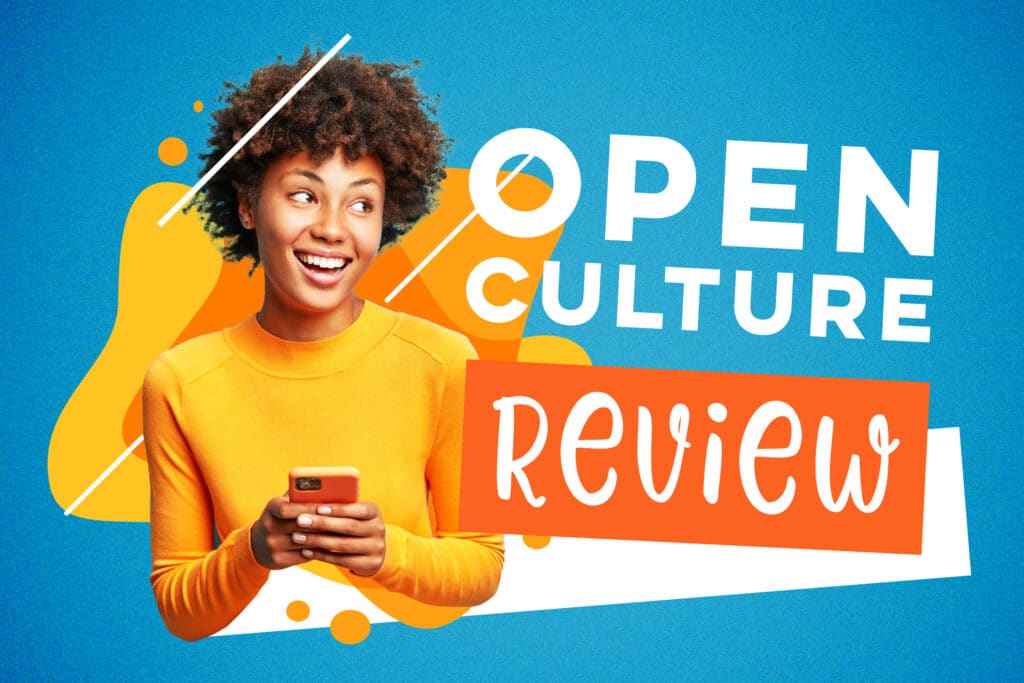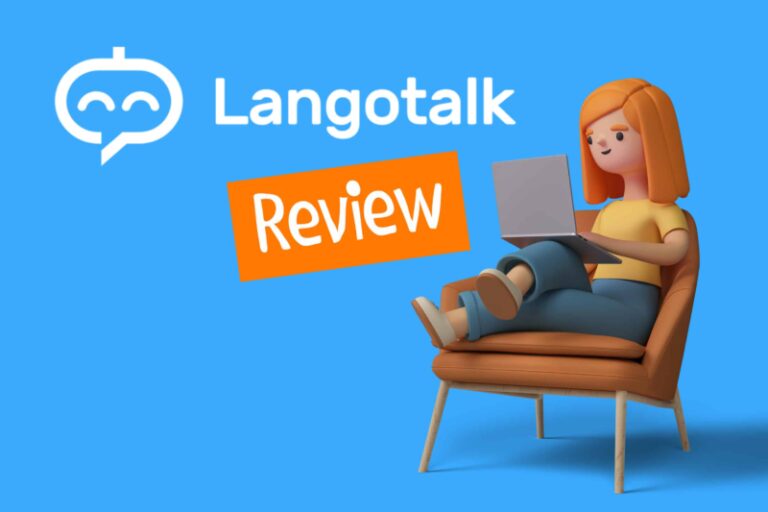Open Culture Review: Great for Uncommon Languages, but Won’t Take You Very Far

I’ve self-studied more than 10 languages in my life, starting with Hindi as a curious (and bored) nine-year-old. So I’ve found myself scouring the Internet for cheap resources more times than the Average Joe.
Open Culture tries to solve this problem by keeping a curated list of completely free resources for 48 languages. I decided to see how much Persian I could learn using only their listed resources while having no history with the language at all.
Overview

Name: Open Culture
Description: A website page that lists free online learning resources for 48 common and rare languages, including Arabic, French, Persian, Maori, Chinese and more.
Offer price: Free
Summary
Open Culture is a free education website that has a language resources page where you can find free online resources to learn 48 languages. It includes many rare and less-studied languages, such as Maori, Amharic, Lao and Bambara, as well as common ones like French, Spanish and Chinese.
-
User friendliness - 8/108/10
-
Delivers on promises - 5/105/10
-
Authenticity - 5/105/10
-
Value for price - 10/1010/10
Pros
- Tons of free resources
- Includes resources for exotic and less common languages
- There’s a wide variety of resource types
- There are resources for dialects of certain languages
- There are lists for non-course resources
Cons
- Many of the links are broken
- Some languages have way more resources than others
- It’s missing some languages that could easily be added
- The list isn’t very updated
- Some of the courses aren’t actually 100% free
Download: This blog post is available as a convenient and portable PDF that you can take anywhere. Click here to get a copy. (Download)
What Is Open Culture and How Does It Work?
Open Culture is a website that links you to resources you can use to learn languages. All the resources are said to be free and they have resource lists for 48 languages total.
You can find all the language resources on Open Culture’s “Languages” page. Each language has its own section with the resources in bullet point lists, accompanied by a link and a short description.
Pros of Open Culture
Tons of free resources
The biggest pro of Open Culture is definitely its resource quantity. I was impressed with how many resources they’ve compiled for so many languages—I felt like I could keep scrolling endlessly.
The Persian section has four resources. I felt like this was the perfect amount to get me started without overwhelming me. I decided I’d use Learn Persian with Chai and Conversation as my main resource and Easy Persian to learn the alphabet and grammar. I wanted to use the Learn Persian Farsi Easily, Effectively, and Fluently podcast as a supplemental resource when I felt like doing a little bit more, but the podcast isn’t actually available anymore.
The fourth one was the least appealing. So I decided not to use it.
Some languages—like French, English and Chinese—have way more resources than other languages. But even though you’ll have to put a little more thought into selecting which ones to use, you’ll still know that whatever you choose will be extremely affordable.
Includes resources for exotic and less common languages
What caught my attention even more than the abundance of resources was the languages they collect resources for. I’ve studied exotic and endangered languages before, and Open Culture would’ve definitely helped me save time searching for affordable, effective resources.
Some examples of the exotic languages included are Amharic, Ancient Greek, Bambara, Lao, Luxembourgish, Māori, Serbo-Croatian and Twi.
There’s a wide variety of resource types
One thing I like about Open Culture is that you’ll find more than just textbooks and online courses. They also include links to podcasts, audiobooks, movies, news websites and more.
There are resources for dialects of certain languages
Something unique about Open Culture is that it offers resources for specific dialects of some languages. A great example of this is the Arabic resources. On the “Free Arabic Lessons” page, you can find resources for Jordanian Arabic, Levantine Arabic and Saudi Arabic.
There are lists for non-course resources
Aside from the free course list, Open Culture also has other lists where you can find things like media, podcasts, books and more.
There’s a movie list with over 4,000 films you can watch for free. Not all of them are in a foreign language—many are in English—but sifting through them or using the handy Ctrl + F to search for your language will help you locate what you want pretty quickly.
Here are a few of the other lists you might enjoy, although they’re not for learning another language:
- 1,000 Free Audio Books: Download Great Books for Free
- 1,700 Free Online Courses from Top Universities
- Online Degrees & Mini Degrees
- The 150 Best Podcasts
Cons of Open Culture
Many of the links are broken
The biggest drawback by far is that many of the links on Open Culture are broken. Even their “about us” page is no longer available but still appears in search results.
Within about two minutes of exploring the language resources page, I came across five broken links. This is especially disappointing for lesser-studied languages, most of which only have one to three links to begin with. For example, Catalan only has one resource listed—a podcast/website called One Minute Catalan—but the link takes you to a nonexistent page.
Some languages have way more resources than others
It makes sense that rare languages have fewer resources than common ones like French and Spanish. But many noteworthy, completely free resources could easily be added to the list.
For example, Open Culture lists Duolingo as a resource for many of the common languages. But Duolingo also has quite a few rare language courses that are missing, like Hawaiian and Navajo, which aren’t even on the list.
Duolingo also has a course for Czech—for example—which currently only has one resource on the Open Culture list. So while Open Culture does provide quite a few high-quality free options, you might find even more just by doing a Google search.
It’s missing some languages that could easily be added
Since Open Culture is only a resource page, it’s missing several languages I expected it to have. For example, I really wanted to learn Tagalog for this challenge, but Tagalog doesn’t even have a list despite there being lots of free resources available online.
Open Culture also includes endangered languages like Maori but not Hawaiian, even though there’s an entire Hawaiian Duolingo course and many free online lessons offered by universities.
The list isn’t very updated
Something I noticed early on while exploring Open Culture was that the list is pretty outdated. And not just because of the broken links and missing languages that could easily have a spot.
Some of the resources have changed their offerings and pricing, so some of them aren’t even free anymore. For example, almost all of the Thai courses are either not available or aren’t actually free.
Other times, certain resources are kept on the list even though they’ve been unavailable for a while. For example, the One Minute Catalan example I gave earlier turns out to be an old Coffee Break Languages course that’s no longer offered. I actually found the lesson archives on Google, but the podcast episodes and study materials can’t be downloaded anymore.
The same thing with the third Persian resource, the Spotify podcast I wanted to use—the page opened, but I couldn’t play any of the episodes because they’d been archived. I tried to find the podcast on my phone instead of my laptop, and it didn’t even appear in the search results.
Some of the courses aren’t actually 100% free
Open Culture advertises its page as a place to find resources you can use to learn languages for free—but many of the resources are now either completely paid with no free version or only offer free trials.
For example, the main resource I used during my time learning Persian—Learn Persian with Chai and Conversation—actually isn’t a free resource. It doesn’t even have a free plan—I just used the 30-day free trial and made the most out of it.
Open Culture Alternatives
Innovative Language
Innovative Language offers tons of language courses, making it an excellent alternative to Open Culture’s resource reference page.
There are eight “featured” languages—Chinese, Italian, Portuguese, French, Japanese, Russian, German, Korean and Spanish—and over 30 other languages. These include less-studied ones like Filipino, Persian, Urdu, Serbian, Nepali, etc.
Signing up for an Innovative Language course gives you lifetime access to a free account, but there are limitations. However, they also usually offer the “Fast Track to Fluency” deal once you sign up, which is only $1. For the Persian course, it includes 30 days of Premium access, 50 exclusive lessons, one free product download and the seven-day “Fluency Fast” course.
FluentU
FluentU isn’t a free resource, but it gives you a 14-day free trial and you can study as many of the offered languages as you want. There are currently 10, including Spanish, Mandarin Chinese, Korean, Russian and more.
FluentU has lessons for all levels, beginner to advanced. It teaches your target language using authentic content so you’re immersed from the very beginning.
As you watch videos—like movie trailers, commercials, TV series clips, etc.—you can click on words in the subtitles you don’t know yet. This shows you the word’s meaning, pronunciation and example sentences. You can then add it to personalized flashcard decks, which use a spaced repetition system to put vocabulary into your long-term memory.
17 Minute Languages
17 Minute Languages offers courses in tons of languages similar to Open Culture’s list, including rare languages like Albanian, Amharic, Georgian, Malaysian and more.
They say that after three hours you can have your first conversation, and 50 hours will make you fluent. It’s called 17 Minute Languages because the program asks you to commit to as little as 17 minutes a day. It uses spaced repetition to teach you the most important words as fast as possible, and they have their own “superlearning technology,” which they say will get you to learn 32% faster.
Final Results: How Much Was I Able to Learn from Open Culture?
I completed two lessons from the two Persian resources I chose out of the four listed on Open Culture (but one was broken). My honest feelings? I’m impressed by how much I learned.
In one hour, I learned 10 letters and how to combine letters (and write words from right-to-left) from the Easy Persian website, which is 100% free. And in 30 minutes, I completed two audio lessons from Chai and Conversation (and did the exercises), learning 33 words total. The only thing I didn’t like was that the Chai and Conversation website isn’t free even though it’s listed on Open Culture—I’ve been using a free trial.
However, Persian was not my first language of choice—or my second, or my third—but it was the only one I felt I could learn using more than one resource (that actually worked) for free. To me, Open Culture didn’t really deliver its promise of free language learning due to the prices of some resources and the fact that many of them were broken links.
In my opinion, Open Culture is a good starting point to find a resource or two that will get you off the ground. But it definitely won’t take you to the advanced level. And for some languages, you might have better luck doing a Google search.






